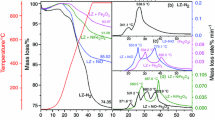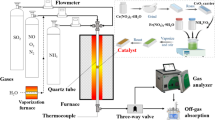Abstract
Siderite is a naturally occurring mineral that can be found extensively in coal. The structural evolution of siderite in the process of coaling and its performance in the transformation of NO in the presence of NH3 were investigated in this work. In addition, the effects of the coexisting component, including vapor, SO2, and the alkali metal K, were also discussed. Heat treatment was performed at 450, 500, 550, 600, and 700 °C to obtain siderite-derived α-Fe2O3, which was then evaluated in de-NOx via the selective catalytic reduction (SCR) of NO with NH3 in a fixed bed. The X-ray diffraction (XRD), the X-ray fluorescence spectrometer (XRF), N2 adsorption-desorption (BET), the X-ray photoelectron spectrometer (XPS), the scanning electron microscope (SEM), and the transmission electron microscope (TEM) were used to investigate the variations in the morphology and structure of the thermally treated siderite. The results showed that siderite was gradually oxidized and decomposed into α-Fe2O3 with a nanoporous structure and large surface area of 27.27 m2 g−1 after calcination under an air atmosphere. The α-Fe2O3 derived from siderite at 500 °C (H500) exhibited an excellent SCR performance, where the NO conversion rate was great than 90% between 250 and 300 °C due to the pore structure and high specific surface area, additional adsorbed oxygen states, abundant oligomeric Fe oxide clusters, and large amount of acid sites. Regardless of the vapor content, SO2 concentration, and reaction temperature, the α-Fe2O3 derived from siderite at 500 °C (H500) still favored the conversion of NO. When the reaction temperature was lower than 350 °C, H500 favored the conversion of NO even in the presence of an alkali metal (K). The experimental data demonstrated the positive effect of siderite-derived α-Fe2O3 in SCR technology and provided insight into NO behavior in coaling flue gas after NH3 injection.








Similar content being viewed by others
References
Apostolescu N, Geiger B, Hizbullah K, Jan MT, Kureti S, Reichert D, Schott F, Weisweiler W (2006) Selective catalytic reduction of nitrogen oxides by ammonia on iron oxide catalysts. Appl Catal B Environ 62:104–114
Balle P, Geiger B, Kureti S (2009) Selective catalytic reduction of NOx by NH3 on Fe/HBEA zeolite catalysts in oxygen-rich exhaust. Appl Catal B Environ 85:109–119
Brandenberger S, Kröcher O, Tissler A, Althoff R (2010) Estimation of the fractions of different nuclear iron species in uniformly metal-exchanged Fe-ZSM-5 samples based on a Poisson distribution. Appl Catal A Gen 373:168–175
Chen L, Weng D, Si Z, Wu X (2012) Synergistic effect between ceria and tungsten oxide on WO3-CeO2-TiO2 catalysts for NH3-SCR reaction. Progr Nat Sci: Mater Int 22:265–272
Dahlin S, Nilsson M, Bäckström D, Bergman SL, Bengtsson E, Bernasek SL, Pettersson LJ (2016) Multivariate analysis of the effect of biodiesel-derived contaminants on V2O5-WO3/TiO2 SCR catalysts. Appl Catal B Environ 183:377–385
Fisher QJ, Raiswell R, Marshall JD (1998) Siderite concretions from nonmarine shales (Westphalian A) of the Pennines, England: controls on their growth and composition. J Sediment Res 68:1034–1045
Forzatti P, Nova I, Tronconi E (2009) Enhanced NH3 selective catalytic reduction for NOx abatement. Angew Chem Int Ed 121:8366–8368
France LJ, Yang Q, Li W, Chen Z, Guang J, Guo D, Wang L, Li X (2017) Ceria modified FeMnOx-enhanced performance and sulphur resistance for low-temperature SCR of NOx. Appl Catal B Environ 206:203–215
Grosvenor AP, Kobe BA, Biesinger MC, Mcintyre NS (2004) Investigation of multiplet splitting of Fe 2p XPS spectra and bonding in iron compounds. Surf Interface Anal 36:1564–1574
Guo RT, Wang QS, Pan WG, Zhen WL, Chen QL, Ding HL, Yang NZ, Lu CZ (2014) The poisoning effect of Na and K on Mn/TiO2 catalyst for selective catalytic reduction of NO with NH3: a comparative study. Appl Surf Sci 317:111–116
Hu H, Zha K, Li H, Shi L, Zhang D (2016) In situ DRIFTs investigation of the reaction mechanism over MnOx-MOy/Ce0.75Zr0.25O2 (M = Fe, Co, Ni, Cu) for the selective catalytic reduction of NOx with NH3. Appl Surf Sci 387:921–928
Iwasaki M, Yamazaki K, Banno K, Shinjoh H (2008) Characterization of Fe/ZSM-5 DeNOx catalysts prepared by different methods: relationships between active Fe sites and NH3-SCR performance. J Catal 260:205–216
Jiang BQ, Wu ZB, Liu Y, Lee SC, Ho WK (2010) DRIFT study of the SO2 effect on low-temperature SCR reaction over Fe-Mn/TiO2. J Phys Chem C 114:4961–4965
Jiang B, Deng B, Zhang Z, Wu Z, Tang X, Yao S, Hao L (2012) Effect of Zr addition on the low-temperature SCR activity and SO2 tolerance of Fe-Mn/Ti catalysts. J Phys Chem C 118:14866–14875
Jing L, Zhiquan T, Yan H, Bin X, He L (2010) Effects of H2O and SO2 on a Cr-Ce/TiO2 catalyst for NO catalytic oxidation. Acta Sci Circumst 30:1023–1029
Kumar MS, Schwidder M, Grünert W, Brückner A (2004) On the nature of different iron sites and their catalytic role in Fe-ZSM-5 DeNOx catalysts: new insights by a combined EPR and UV/VIS spectroscopic approach. J Catal 227:384–397
Li J, Xiong D (2009) Tribological behavior of graphite-containing nickel-based composite as function of temperature, load and counterface. Wear 266:360–367
Li Q, Liu H, Chen T, Chen D, Zhang C, Xu B, Zhu C, Jiang Y (2017) Characterization and SCR performance of nano-structured iron-manganese oxides: effect of annealing temperature. Aerosol & Air Quality Research 17:2328–2337
Liang Y, Huang Y, Zhang H, Lan L, Zhao M, Gong M, Chen Y, Wang J (2017) Interactional effect of cerium and manganese on NO catalytic oxidation. Environ Sci Pollut Res Int 24:9314–9324
Liu F, He H, Zhang C, Feng Z, Zheng L, Xie Y, Hu T (2010) Selective catalytic reduction of NO with NH3 over iron titanate catalyst: catalytic performance and characterization. Appl Catal B Environ 96:408–420
Liu F, He H, Zhang C, Shan W, Shi X (2011) Mechanism of the selective catalytic reduction of NOx with NH3 over environmental-friendly iron titanate catalyst. Catal Today 175:18–25
Liu Z, Li J, Woo SI (2012) Recent advances in the selective catalytic reduction of NOx by hydrogen in the presence of oxygen. Energy Environ Sci 5:8799–8814
Liu C, Yang S, Ma L, Peng Y, Hamidreza A, Chang H, Li J (2013) Comparison on the performance of α-Fe2O3 and γ-Fe2O3 for selective catalytic reduction of nitrogen oxides with ammonia. Catal Lett 143:697–704
Liu Z, Zhang S, Li J, Zhu J, Ma L (2014) Novel V2O5-CeO2/TiO2 catalyst with low vanadium loading for the selective catalytic reduction of NOx by NH3. Appl Catal B Environ 158–159:11–19
Liu H, Zhang L, Li Q, Zhu H, Deng L, Liu Y, Che D (2019) Effect of FGR position on the characteristics of combustion, emission and flue gas temperature deviation in a 1000 MW tower-type double-reheat boiler with deep-air-staging. Fuel 246:285–294
Maes II, Gryglewicz G, Yperman J, Franco DV, D'Haes J, D'Olieslaeger M, Poucke LCV (2000) Effect of siderite in coal on reductive pyrolytic analyses. Fuel 79:1873–1881
Metkar PS, Harold MP, Balakotaiah V (2012) Selective catalytic reduction of NOx on combined Fe- and Cu-zeolite monolithic catalysts: sequential and dual layer configurations. Appl Catal B Environ 111–112:67–80
Odenbrand CUI, Gabrielsson PLT, Brandin JGM, Andersson LAH (1991) Effect of water vapor on the selectivity in the reduction of nitric oxide with ammonia over vanadia supported on silica-titania. Appl Catal 78:109–122
Ren Z, Hao F, Rui W (2017) A novel ring-like Fe2O3-based catalyst: tungstophosphoric acid modification, NH3-SCR activity and tolerance to H2O and SO2. Catal Commun 100:71–75
Shen B, Yao Y, Hongqing MA, Liu T (2011) Ceria modified MnOx/TiO2-pillared clays catalysts for the selective catalytic reduction of NO with NH3 at low temperature. Chin J Catal 32:1803–1811
Tao Z, Qu R, Su W, Li J (2015) A novel Ce-Ta mixed oxide catalyst for the selective catalytic reduction of NOx with NH3. Appl Catal B Environ 176-177:338–346
Wang ZM, Yamaguchi M, Goto I, Kumagai M (2000) Characterization of Ag/Al2O3 de-NOx catalysts by probing surface acidity and basicity of the supporting substrate. Phys Chem Chem Phys 2:3007–3015
Wang XT, Hu HP, Zhang XY, Su XX, Yang XD (2019) Effect of iron loading on the performance and structure of Fe/ZSM-5 catalyst for the selective catalytic reduction of NO with NH3. Environ Sci Pollut Res Int 26:1706–1715
Xie B, Luo H, Tang Q, Du J, Liu Z, Tao C (2017) The black rock series supported SCR catalyst for NOx removal. Environ Sci Pollut Res Int 24:21761–21769
Xiong Z, Lu C, Guo D, Zhang X, Han K (2013) Selective catalytic reduction of NOx with NH3 over iron-cerium mixed oxide catalyst: catalytic performance and characterization. J Chem Technol Biotechnol 88:1258–1265
Yang S, Wang C, Li J, Yan N, Ma L, Chang H (2011) Low temperature selective catalytic reduction of NO with NH3 over Mn-Fe spinel: performance, mechanism and kinetic study. Appl Catal B Environ 110:71–80
Yang S, Wang C, Chen J, Peng Y, Ma L, Chang H, Chen L, Liu C, Xu J, Li J, Yan N (2012) A novel magnetic Fe-Ti-V spinel catalyst for the selective catalytic reduction of NO with NH3 in a broad temperature range. Catalysis Science & Technology 2:915
Yang S, Liu C, Chang H, Ma L, Qu Z, Yan N, Wang C, Li J (2013) Improvement of the activity of γ-Fe2O3 for the selective catalytic reduction of NO with NH3 at high temperatures: NO reduction versus NH3 oxidization. Ind Eng Chem Res 52:5601–5610
Ye J, Xiang G, Weihong WU (2013) Effects of H2O and SO2 on the performance of V2O5/TiO2 catalysts for selective catalytic reduction of NO in flue gas. Proc CSEE 33:28–33
Zhang L, Zhang D, Zhang J, Cai S, Fang C, Huang L, Li H, Gao R, Shi L (2013) Design of meso-TiO2@MnO(x)-CeO(x)/CNTs with a core-shell structure as DeNO(x) catalysts: promotion of activity, stability and SO2-tolerance. Nanoscale 5:9821–9829
Zhang W, Shi Y, Li C, Zhao Q, Li X (2016) Synthesis of bimetallic MOFs MIL-100 (Fe-Mn) as an efficient catalyst for selective catalytic reduction of NOx with NH3. Catal Lett 146:1956–1964
Zhang C, Chen T, Liu H, Chen D, Xu B, Qing C (2018) Low temperature SCR reaction over nano-structured Fe-Mn oxides: characterization, performance, and kinetic study. Appl Surf Sci 457:1116–1125
Zhou H, Su Y, Liao W, Deng W, Zhong F (2016) NO reduction by propane over monolithic cordierite-based Fe/Al2O3 catalyst: reaction mechanism and effect of H2O/SO2. Fuel 182:352–360
Zhou X, Huang X, Xie A, Luo S, Yao C, Li X, Zuo S (2017) V2O5-decorated Mn-Fe/attapulgite catalyst with high SO2 tolerance for SCR of NOx with NH3 at low temperature. Chem Eng J
Zhu ZP, Liu ZY, Liu SJ, Niu HX, Hu TD, Liu T, Xian YN (2000) Flue gas NOx removal by SCR with NH3 on CuO/AC at low temperatures. Stud Surf Sci Catal 130:1385–1390
Zhu Z, Liu Z, Niu H, Liu S, Hu T, Liu T, Institute of Coal Chemistry, Chinese Academy of Sciences, Taihuan (2001) Mechanism of SO2 promotion for NO reduction with NH3 over activated carbon-supported vanadium oxide catalyst. J Catal 197:6–16
Zhu L, Zhong Z, Yang H, Wang C (2016) NH3-SCR performance of Mn-Fe/TiO2 catalysts at low temperature in the absence and presence of water vapor. Water Air Soil Pollut 227:476
Zi Z, Zhu B, Sun Y, Fang Q, Ge T (2019) Promotional effect of Mn modification on DeNOx performance of Fe/nickel foam catalyst at low temperature. Environ Sci Pollut Res Int 26:10117–10126
Funding
This study was financially supported by the National Natural Science Foundation of China (Nos. 41772038, 41672040, 41572029) and Anhui Provincial Natural Science Foundation (1708085MD87).
Author information
Authors and Affiliations
Corresponding author
Additional information
Responsible editor: Philippe Garrigues
Publisher’s note
Springer Nature remains neutral with regard to jurisdictional claims in published maps and institutional affiliations.
Electronic supplementary material
ESM 1
(DOC 19 kb)
Rights and permissions
About this article
Cite this article
Shu, D., Liu, H., Chen, T. et al. The positive effect of siderite-derived α-Fe2O3 during coaling on the NO behavior in the presence of NH3. Environ Sci Pollut Res 27, 12376–12385 (2020). https://doi.org/10.1007/s11356-020-07829-x
Received:
Accepted:
Published:
Issue Date:
DOI: https://doi.org/10.1007/s11356-020-07829-x




